Cerca per articoli, rubriche o altro
cerca per rubrica

Cerca per articoli, rubriche o altro

La nuova collezione Andromeda di UniFor, firmata dallo studio LSM Studio, trae ispirazione da un'originale opera d'arte en plain air situata in cima a una collina.
Sui monti Sicani della Sicilia si trova il Teatro Andromeda, un teatro all'aperto costruito nel corso di molti anni dall'artista e pastore Lorenzo Reina.
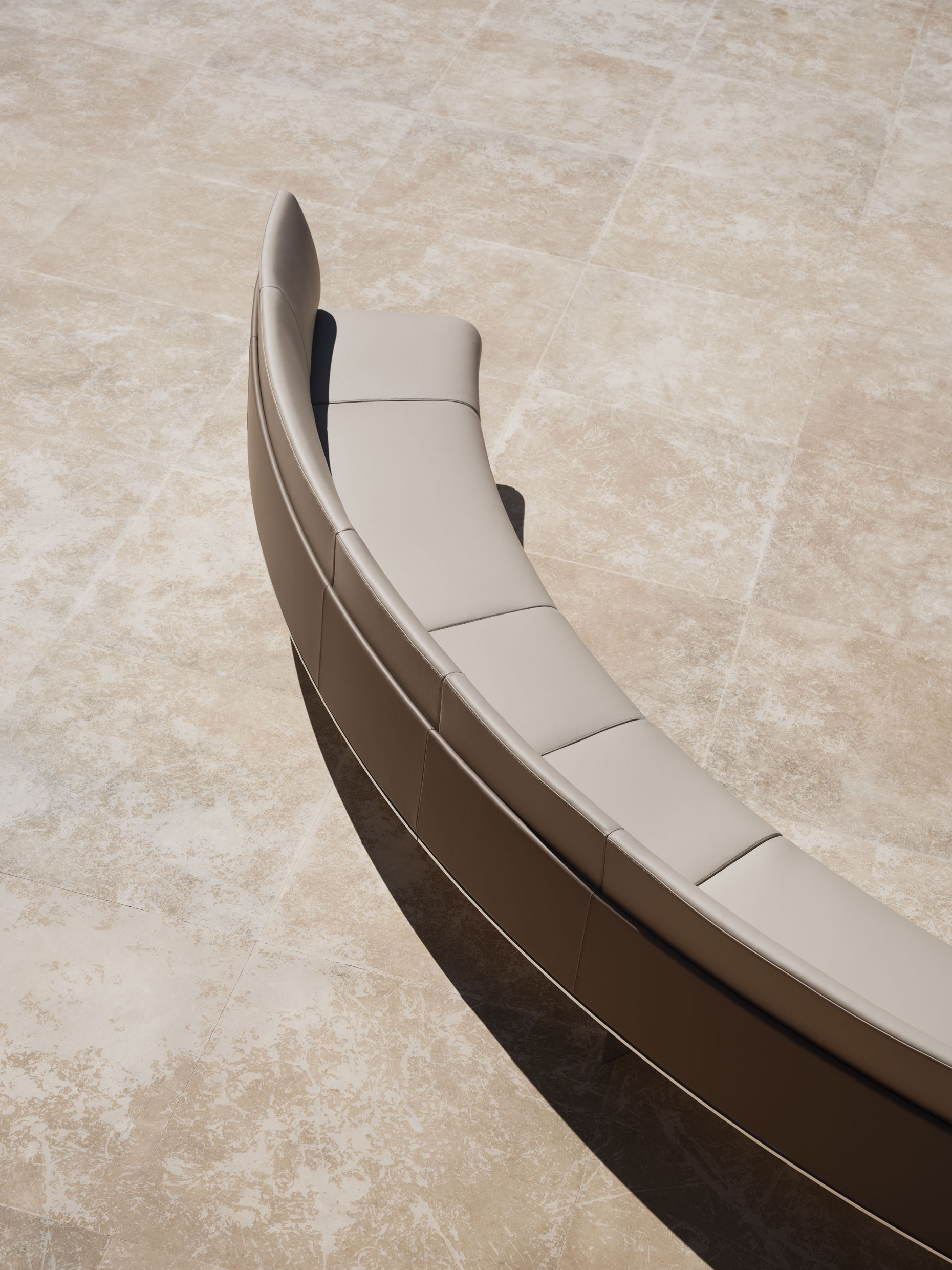 Detail of the joining of two modules of the curved sofa – ph. Alberto Strada
Detail of the joining of two modules of the curved sofa – ph. Alberto Strada
In questa remota regione rurale, la vista suggestiva del teatro di pietra è pari solo a quella della sua posizione collinare, un luogo dove il cielo e la Terra si incontrano. Situato ad un'altitudine prossima ai 1.000 metri, il Teatro Andromeda è uno dei teatri all'aperto più ‘alti’ del mondo. Eppure, avvicinandovisi, i visitatori vedono solo il muretto a secco di un ovile come tanti altri della regione. Tra queste pietre naturali, però, ce ne sono alcune che sono state cesellate in modo più preciso con linee nette. Due di queste grandi pietre fiancheggiano l'ingresso del teatro, prima che lo spazio si apra per rivelare un palco circolare e sedute geometriche in pietra.
Reina proviene da una famiglia di pastori, ma si è appassionato all'arte fin da giovane. Aveva considerato una carriera in campo artistico, ma una volta coinvolto nella gestione dell’azienda agricola di famiglia ha dovuto conciliare questi due aspetti della sua vita. Autodefinitosi ‘scultore-pastore’, Reina ha creato uno spazio per l'arte all'interno dei suoi 300 ettari di pascolo, nel paese di Santo Stefano Quisquina, in provincia di Agrigento.
“Lo spirito, come il vento, soffia dove vuole, e ha soffiato qui, in questo luogo dove portavo le pecore a pascolare,” dice. “E stranamente, come incantate, le pecore sembravano restare ferme come pietre, ruminando immobili. Ho percepito una strana energia fluire da questo luogo e ho iniziato a raccogliere qui le prime pietre.”
 Linear sofa with cantilevered leather covered armrest tables at either end – ph. Alberto Strada
Linear sofa with cantilevered leather covered armrest tables at either end – ph. Alberto Strada
Reina ha dato il nome al teatro in seguito a una lettura riguardante la galassia di Andromeda, o galassia M31, parte della costellazione di Andromeda. Identificata per la prima volta dall'astronomo greco-romano Tolomeo e inclusa nell'Almagesto (la sua guida astronomica del II secolo), la costellazione è dedicata al mito di Andromeda, figlia della regina Cassiopea e del re Cefeo dell'antica Etiopia. La storia racconta che il re fu punito dagli dei per aver arrogantemente suggerito che la figlia fosse più bella delle divinità. Come penitenza, Andromeda fu incatenata a una roccia sulla costa per essere sacrificata al mostro marino Cetus (per questo si dice che le stelle più luminose della costellazione mappino la figura di Andromeda con le braccia aperte e legate), prima di essere salvata dall'eroe greco Perseo.
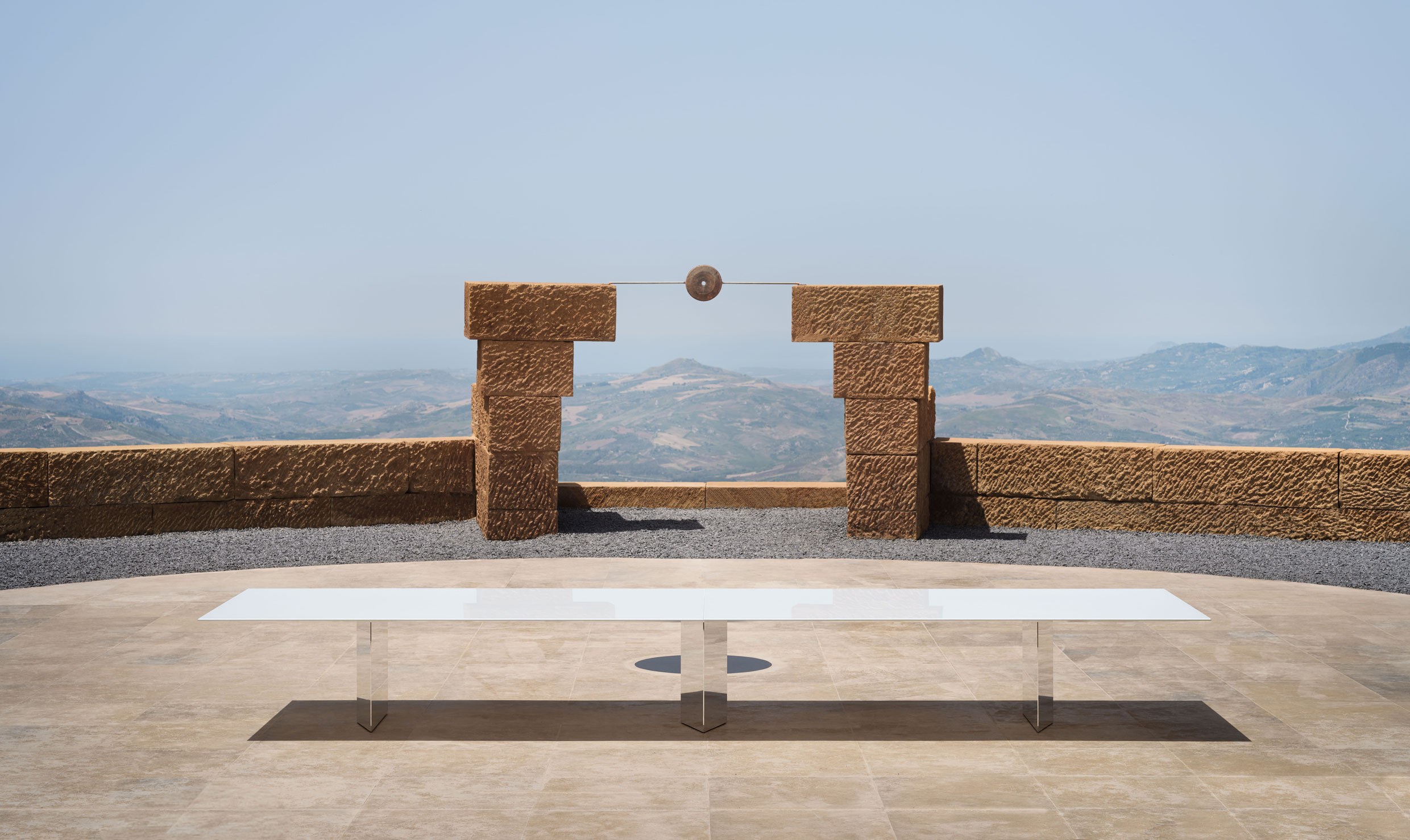
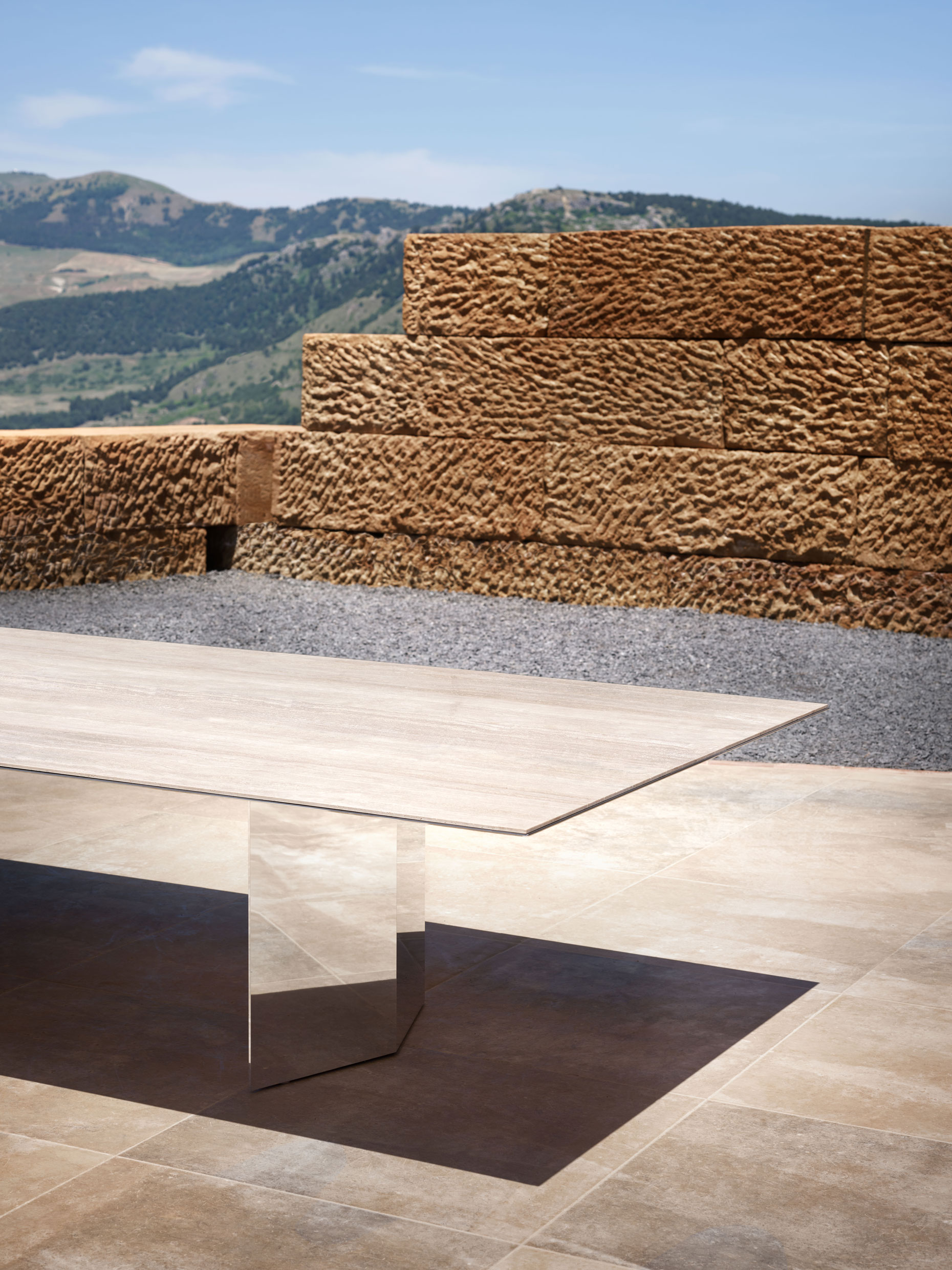 Detail of the rectangular table with travertine top – ph. Alberto Strada
Detail of the rectangular table with travertine top – ph. Alberto Strada
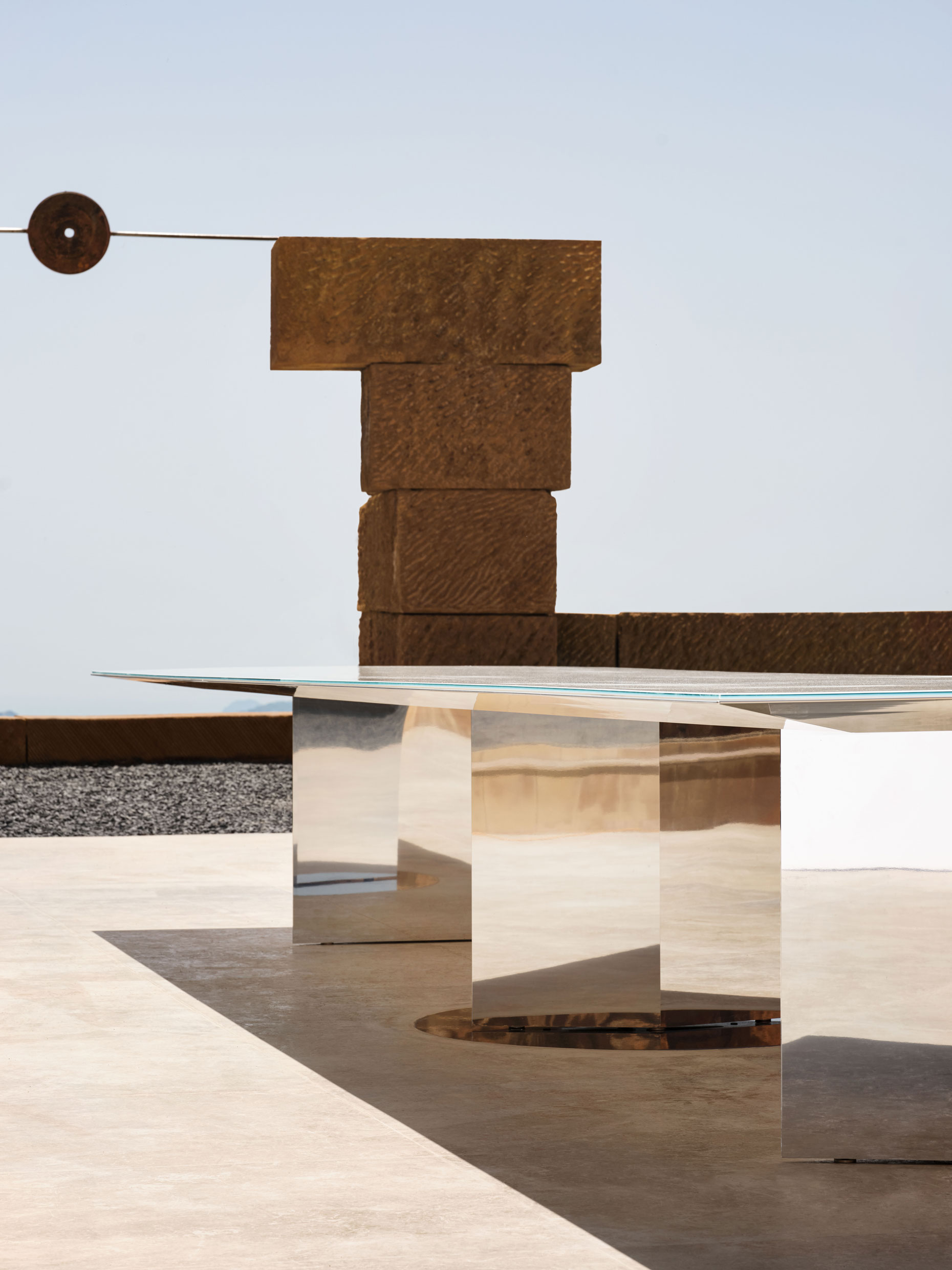 Detail of the rectangular table with extra-clear white back-painted glass top – ph. Alberto Strada
Detail of the rectangular table with extra-clear white back-painted glass top – ph. Alberto Strada
Posto al confine tra Terra e cielo, il teatro è costruito con materiali solidi, forme geometriche che prendono nuova vita con il mutare della luce del cielo. I suoi 108 posti a sedere in pietra appaiono sparsi piuttosto che disposti in file regolari, ma corrispondono accuratamente agli astri della costellazione. Dall'alto appaiono come stelle a otto punte, composte da due blocchi cubici impilati e ruotati a 45 gradi l'uno sull'altro. Un disco metallico, posto sopra l’arco alle spalle del palco, funge da punto focale.
Opera d'arte e architettura site-specific, il Teatro Andromeda è stato progettato per conciliare le tensioni drammatiche di entrambe le forme: “In questo modo, ho cercato di conformare il teatro alla natura che si mette in scena.” Circondato da nuvole e montagne, lo sfondo non può fare a meno di conferire la propria drammaticità alle produzioni che vi si svolgono. Intorno al teatro, si trovano diverse opere e strutture realizzate da Reina e altri artisti, che costituiscono la sua Fattoria dell'Arte. La scultura Icaro Morente di Giuseppe Agnello, in cui Icaro giace prostrato a terra dopo la sua caduta dal cielo e circondato da piume, mentre l'accesso al teatro porta i visitatori davanti alla scultura dello stesso Reina, Imago della Parola, una grande maschera verticale con fori per gli occhi e una bocca che si riempie di luce al solstizio d'estate.
Con la sua purezza di materiali, l'accurata lavorazione e la drammaticità visiva, non sorprende che il Teatro Andromeda si sia rivelato fonte di ispirazione per i designer. Nel 2018, il teatro è stato tra i progetti selezionati dall'architetto Mario Cucinella per la mostra ‘Arcipelago Italia’ al padiglione Italia alla Biennale Internazionale di Architettura di Venezia: visione unica di un individuo che è allo stesso tempo pastore e artista, un'opera di architettura nata dalla terra e dalle tradizioni della sua lavorazione. E ora il sito ha ispirato la collezione Andromeda di UniFor, che debutta alla Milano Design Week 2024.
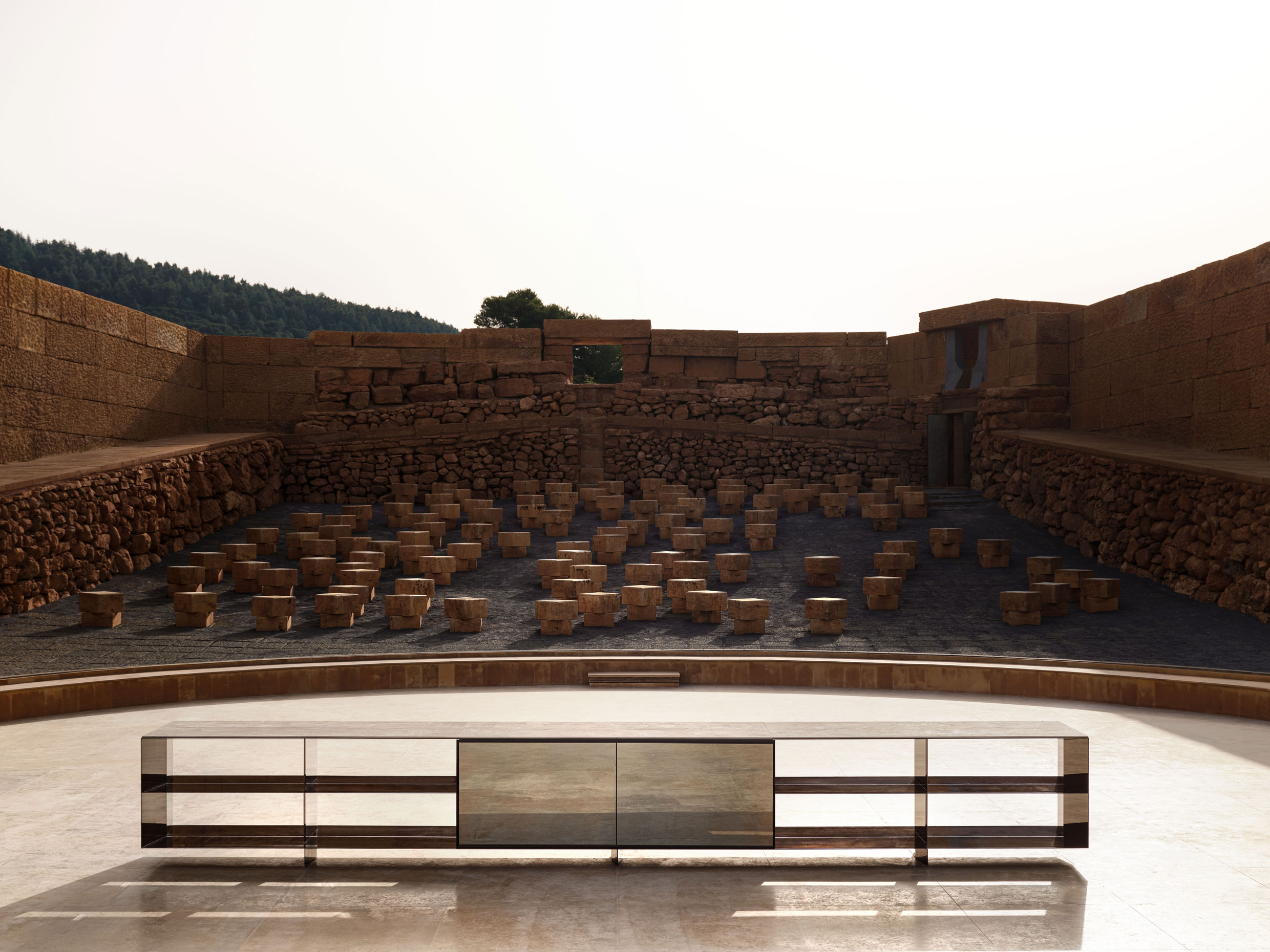
Firmato dallo studio LSM, il progetto della collezione Andromeda è stato guidato da Debra Lehman Smith e da Mark Alan Andre. Dopo una collaborazione di 30 anni, basata in prevalenza su progetti specifici, questa è la prima collezione lanciata da LSM e UniFor. Nonostante l'ampia distribuzione, la collezione rimane in stretto dialogo con il sito che l'ha ispirata.
Marco Maturo, cofondatore di Studio Klass e direttore artistico di UniFor e Citterio, racconta di essersi imbattuto nella storia di Reina e del suo teatro mentre cercava un sito architettonico singolare in Italia ed è stato attratto dal suo stile unico e ‘autarchico’. “Questo teatro nel mezzo della Sicilia è stato progettato da una persona che non aveva clienti, quindi era completamente libero,” afferma. Per lo sviluppo della collezione, Maturo ha incontrato Reina, che gli ha raccontato di aver studiato arte a Roma, dove è stato influenzato dall'architetto Aldo Rossi. In particolare, Reina si è ispirato a Il Teatro del Mondo di Rossi realizzato nel 1979 per la Biennale di Venezia. Anche Reina espone le sue opere dal 1979, ma è il Teatro Andromeda a rappresentare il risultato più importante della sua lunga carriera.
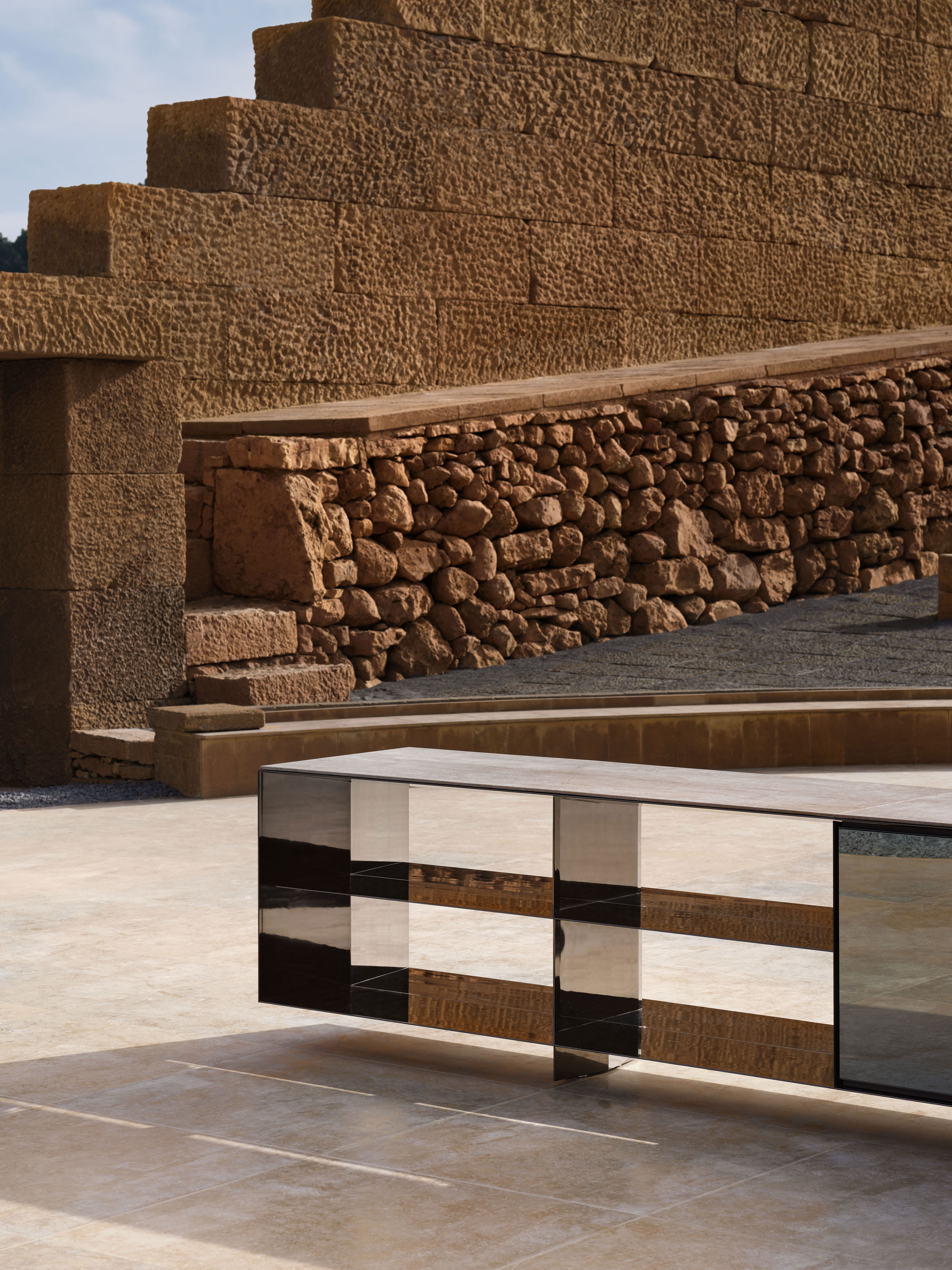 Detail of the credenza in black chrome aluminum and travertine top – ph. Alberto Strada
Detail of the credenza in black chrome aluminum and travertine top – ph. Alberto Strada
Descrivendo il Teatro Andromeda come una via di mezzo tra un teatro greco tradizionale e qualcosa di più esoterico, con un innato “senso del bello”, Maturo spiega che UniFor e LSM Studio sono stati immediatamente ispirati dal sito. “La purezza di questo luogo ci è sembrata subito in grado di ripristinare quella linea sottile tra delicatezza e rigore, cuore concettuale della collezione,” racconta.
Oltre all’abilità artigianale e all’approccio esigente di Reina, che lo hanno visto perfezionare il Teatro Andromeda nel corso di decenni, è anche la natura senza tempo dell’opera d’arte ad affascinare.
“Simboleggia davvero questa collezione perché non si tratta del passato,” spiega Lehman Smith. “Non si tratta del futuro. Non si tratta di una tendenza. E non è definita da un singolo momento del tempo.”
La collezione – composta da tavoli, credenze e divani realizzati in alluminio brillantato, travertino, pelle e vetro – mescola forme curve e angolari, proprio come l'architettura del teatro. Collocato nel Teatro Andromeda, ad esempio, il divano curvo della collezione, pensato per le aree lounge o di attesa degli ambienti di lavoro, evoca la circolarità del palcoscenico, mentre la finitura riflettente delle sue credenze monolitiche e le solide gambe romboidali dei tavoli riproducono le montagne circostanti, mentre il piano orizzontale del tavolo quasi scompare nell'orizzonte.
 Round and elliptical coffee tables, with mirror-polished metal structure - ph. Alberto Strada
Round and elliptical coffee tables, with mirror-polished metal structure - ph. Alberto Strada
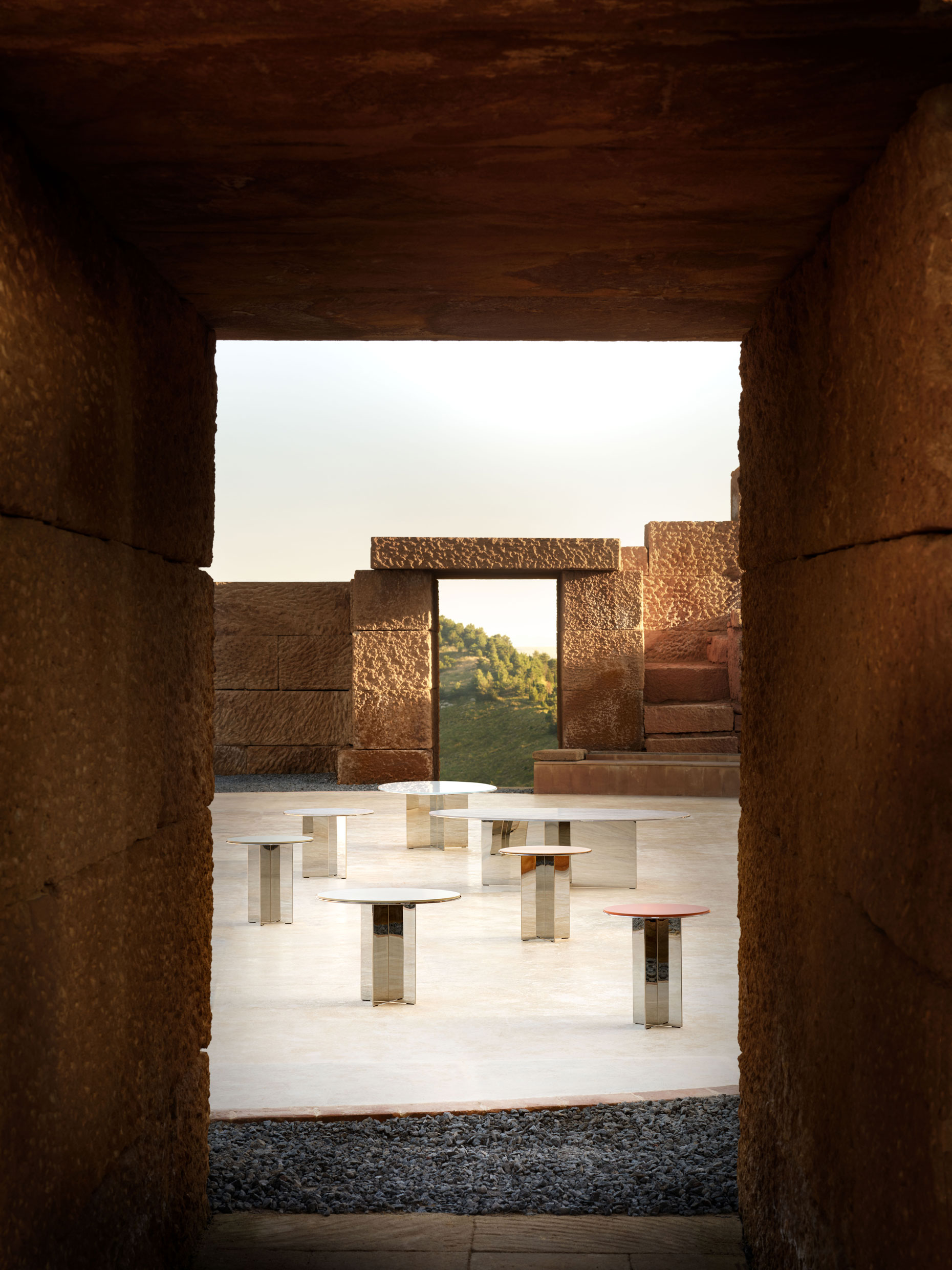 Round and elliptical coffee tables in various sizes and tops - ph. Alberto Strada
Round and elliptical coffee tables in various sizes and tops - ph. Alberto Strada
Maturo ha scelto di fotografare la collezione Andromeda di UniFor nel Teatro Andromeda, in collaborazione con il fotografo Alberto Strada, con un editing minimo, “perché abbiamo fatto del nostro meglio per riprodurre le sensazioni che abbiamo provato lì.” Scattando all'alba e al tramonto, “inseguendo la luce,” dice Maturo, gli arredi “fluttuavano tra il cielo e la terra, a seconda di come ci si muoveva intorno ad essi. In quel luogo, si percepiscono due elementi: il primo è la Terra, e il secondo è il cielo; è uno spazio che si dividono a metà.”
Main image: overview of a four-module composition of the curved sofa. The elements are linked together by an integrated proprietary joint system – ph. Alberto Strada
Le ‘standing desk’ vantano una storia lunga e illustre, i primi sostenitori commissionavano scrivanie alte direttamente ai falegnami, oppure sfruttavano i ripiani più alti delle librerie, fino all’invenzione dei desk regolabili. L’ultima postazione di UniFor - Spring System, firmato dall’architetto Antonio Citterio - sfrutta invece delle molle (springs) per compensare il peso della scrivania durante la salita.
Quando quest’anno la sedia Monk rientrerà nel catalogo Molteni&C, saranno passati 35 anni dall’ultima volta che è stata prodotta. “Disegnata da Afra e Tobia Scarpa, ‘Monk’ è semplice e solida,” recitava il catalogo aziendale del 1990.
UniArm: “É tutto molto chiaro”
Il catalogo di UniArm, il nuovo braccio per monitor di UniFor, si apre con alcune pagine di fotografie ravvicinate della forma elegante e snodabile del braccio, seguite da una doppia pagina di immagini radiografiche del prodotto.
Grazie per esserti registrato.